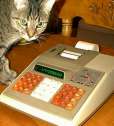Hewlett-Packard HP-32SII Silver
| Datasheet legend
Ab/c:
Fractions calculation
AC: Alternating current BaseN: Number base calculations Card: Magnetic card storage Cmem: Continuous memory Cond: Conditional execution Const: Scientific constants Cplx: Complex number arithmetic DC: Direct current Eqlib: Equation library Exp: Exponential/log functions Fin: Financial functions Grph: Graphing capability Hyp: Hyperbolic functions Ind: Indirect addressing Intg: Numerical integration Jump: Unconditional jump (GOTO) Lbl: Program labels LCD: Liquid Crystal Display LED: Light-Emitting Diode Li-ion: Li-ion rechargeable battery Lreg: Linear regression (2-var. stats) mA: Milliamperes of current Mtrx: Matrix support NiCd: Nickel-Cadmium recharg. batt. NiMH: Nickel-metal-hydrite rech. batt. Prnt: Printer RTC: Real-time clock Sdev: Standard deviation (1-var. stats) Solv: Equation solver Subr: Subroutine call capability Symb: Symbolic computing Tape: Magnetic tape storage Trig: Trigonometric functions Units: Unit conversions VAC: Volts AC VDC: Volts DC |
| ||||||||||||||||||||||||||||||||||||||||||||||||||||||||
Hewlett-Packard HP-32SII Silver
 Is it possible that I am holding the very last RPN calculator from Hewlett-Packard in my hands? I sure hope not, but with the recent discontinuation of the HP-32SII, for the first time in 30 years, Hewlett-Packard no longer sells a "reverse Polish" scientific calculator. Reverse Polish notation is not completely dead yet: it lives on in the form of the HP-12C and some not-yet discontinued graphing calculators with RPL programmability. But a plain simple scientific calculator with RPN appears to be a thing of the past.
Is it possible that I am holding the very last RPN calculator from Hewlett-Packard in my hands? I sure hope not, but with the recent discontinuation of the HP-32SII, for the first time in 30 years, Hewlett-Packard no longer sells a "reverse Polish" scientific calculator. Reverse Polish notation is not completely dead yet: it lives on in the form of the HP-12C and some not-yet discontinued graphing calculators with RPL programmability. But a plain simple scientific calculator with RPN appears to be a thing of the past.
The only difference between this "silver bezel" version and the original HP-32SII is cosmetic: the colors of the metal bezel are more psychedelic, with the display surrounded by a silver rectangle.
That we live in penny-pinching times when it comes to mass produced goods is evident from the Spanish-language packaging of this HP-32SII that I just received. No, I'm not referring to the fact that it is a blister pack: that we're already used to. It is what is written on the package that caught my attention (actually, the attention of the kind chap in Spain who found this unit for me.) You see, the packaging (printed by the Hewlett-Packard Company) says the following on the back:
ALIMENTACION: 4.5V (3 Pilas AAA)
Yet no matter how hard I look, I cannot find any AAA batteries in this calculator. Which shouldn't be a surprise, since it already has three perfectly functional LR44 button cells installed in the appropriate location, so there really is no need for any AAA batteries. The button cells do a fine job powering the calculator, as indeed they have since the day the first Voyager series machines like the HP-15C were introduced.
The programming example for the HP-32SII is one I originally wrote when I first received a "brown bezel" version of this machine. It is based on a Russian programmable calculator algorithm, and it computes the logarithm of the complex Gamma function. To use the program, just enter the imaginary part, hit ENTER, enter the real part, and hit XEQ I. Make sure the calculator is in radians mode, otherwise the result will not be correct.
This program is not as accurate as the one I wrote for the HP-32S, but it sure requires a lot less program space.
I01 LBL I CK=92AE 010.5 I02 STO B I03 x<>y I04 STO A I05 0 I06 STO C I07 STO D H01 LBL H CK=DC88 079.5 H02 XEQ K H03 XEQ J H04 RCL B H05 1 H06 + H07 STO B H08 12 H09 - H10 x<0? H11 GTO H H12 XEQ K H13 2 H14 1/x H15 RCL B H16 - H17 STO H H18 RCL E H19 × H20 RCL F H21 RCL A H22 × H23 + H24 RCL F H25 RCL H H26 × H27 RCL E H28 RCL A H29 × H30 - H31 XEQ J H32 RCL B H33 RCL G H34 12 H35 × H36 STO G H37 ÷ H38 RCL B H39 - H40 RCL A H41 +/- H42 RCL G H43 ÷ H44 RCL A H45 - H46 XEQ J H47 π H48 2 H49 × H50 SQRT H51 LN H52 + H53 RTN J01 LBL J CK=F14A 013.5 J02 RCL D J03 + J04 STO D J05 x<>y J06 RCL C J07 + J08 STO C J09 RTN K01 LBL K CK=A6EE 030.0 K02 RCL B K03 ENTER K04 x2 K05 RCL A K06 x2 K07 + K08 STO G K09 SQRT K10 STO H K11 ÷ K12 ACOS K13 +/- K14 STO F K15 RCL H K16 LN K17 +/- K18 STO E K19 x<>y K20 RTN


